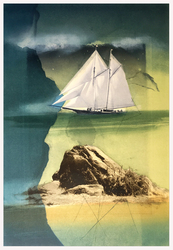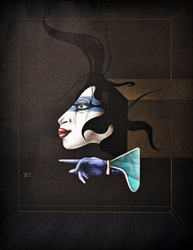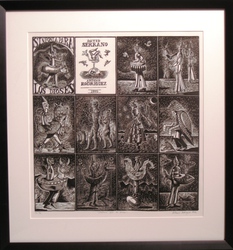Author: Scott Peterson
Kogyo Tsukioka’s Funabashi: The Floating Bridge

By Eva Allan
We had an unforeseeably long time to live with a print from the GALC; we checked it out more than a year ago, pre-lockdown, and then it became our COVID companion artwork. A Japanese print by Kogyo Tsukioka, Funabashi: The Floating Bridge, it depicts a scene from traditional Noh theater. The plot of the play, as described by the writing on the print, involves lovers separated first by a river and then by death–their disapproving families removed part of the bridge and the man drowned, becoming a lingering spirit searching for rest in the afterlife.
In this scene, the actor playing the woman stands just to the left of the center of the print, by the edge of the doorway or big window. On the other side of the jamb, the actor playing the man-spirit stands behind some railings of a bridge. We can see neither his feet nor the surface on which he stands, which helps us understand the supernatural nature of the “floating bridge.” A pine tree, also with an indeterminate base, appears on the left, also obscuring the supports of the bridge. The pine, long-lived and evergreen, could symbolize remembrance, longevity, and steadfast, undying love (as it does elsewhere in Japanese literature).
One of the pleasures of viewing original artwork is enjoying details you can’t easily appreciate in reproduction. With just a few lines, Tsukioka indicates the sag of organic skin under the painted wooden masks. We see the ribbon that ties the woman’s mask behind the actor’s head. The masks and costumes contribute to the theatrical nature of the characters: the man wears a jacket with enormous grey sleeves and a wide-legged blue pants; his mask is exaggeratedly masculine under an enormous wig; his outfit boasts large-scale patterns with big bamboo leaves and twisting black birds, but with subtle grey and blue colors. The fabric of the woman character’s kimono features a delicate, repeating floral pattern, with heart-shaped leaves like a domestic begonia or violet. Long, abstract narrow ribbons and lapping waves pattern her kimono, wrapping around the actor like fingers, and echo the grasp of her hand that holds in the heavy fabric (in the absence of a belt/obi). This fabric may make her character seem more demure and confined, but her kimono features a prominent red-orange fabric, the strongest color of the print, and she is placed just off center, which contributes to the tension felt between the two tragically separated characters.
We hung this print next to our own impression of the Nihonbashi Bridge in Snow by Hiroshige, which my husband bought when he visited Japan for a conference as a graduate student. The prominent bridge in the Hiroshige emphasized the small bridge depicted by Tsukioka, but the juxtaposition brought out many more differences between the prints. The Nihonbashi Bridge was more about everyday people going about daily errands and the busy world of commerce; because of the snow but also because of their tasks they keep their heads down and hurry towards their purposes. The Funibashi: Floating Bridge scene exists outside of the daily rush, outside even of worldly time, in a fantastic, theatrical setting.
Then, the COVID crisis meant that we all entered a stay-at-home lockdown. During this strange time, the Floating Bridge print took on new layers of meaning: the man and woman seemed to be on opposite sides of a big pane of glass, paralleling our own separation from the world. The Hiroshige print, with its bustle, business, and commercial activity, suddenly became cold and unrelatable, as we stopped running errands or hurrying to school and work. We stayed inside, looking out of the window or at a computer screen; our days merged into a timeless otherworldliness. The characters in the Floating Bridge scene became closer to the daily images on the news: they were like the musicians on balconies in Italy, encouraging healthcare workers; like the teddy bears placed in the windows to delight children on neighborhood walks; or the rainbows drawn by children and taped on windows to symbolize hope in the midst of the COVID-crisis. The separated lovers came to resemble nursing home residents and their visitors, separated by glass windows, unable to embrace.
Too soon, the Floating Bridge print became a reminder of the deaths of so many loved ones, now hundreds of thousands on the other side of the bridge of mortality. So many COVID victims had to say goodbye to their families separated by glass or by screens, wearing masks or otherworldly ventilators and oxygen tubes, barred and blockaded from corporal human touch.
In the end, there is that little pine. Both figures in the Floating Bridge scene turn towards it, rather than making eye contact with each other. It isn’t tall, just a bushy sapling really. Tsukioka allows it to come into the woman’s space, although it seems more likely to be growing outside next to the bridge, as in a Japanese garden. This modest pine becomes the symbol of life beyond human lifespan, of hope that the coronavirus wouldn’t keep us separated from our families forever, and of love that could last beyond mortality.
Thank you for allowing us to keep this print during the lockdown time, for waiving late fees and extending due dates. The extra time offered more moments of spontaneous insight. It encouraged long looking in a year when much of our attention was given to the distraction of computer screens. It was extraordinary to live with an original artwork that seemed to gather new harrowing meaning in this unusual and difficult year, and I’m grateful for the extra time we had with this print.
Graphic Knowledge: Perspectives on Prints and Printmaking at UC Berkeley
Come spend your Wednesdays in October from 4:10-5pm learning about the Graphic Arts Loan Collection and printmaking at UC Berkeley. All events will be online through Zoom and open to the public. Registration for each event can be found below or right here.

Registration can be found here for Impressive Art: An Artists Panel on Printmaking.
Stephen Longstreet’s Untitled, Still-Life with Fruit

By Julia Hedelman
So grateful for this program! GALC provides a wonderful opportunity for students who may be limited for financial reasons or otherwise to make their living space feel more homey and comfortable. The pieces I had during my time at Cal were beautiful and I think it’s a lovely way to showcase art that may otherwise be sitting collecting dust in a basement for no one to enjoy. Hope this program can continue for many years to come! Thank you.
2019/20 Art Practice & University Library Printmaking Award Winner: Madison Nelson
Madison Nelson is a 2020 graduate from the Department of Art Practice at UC Berkeley. She grew up around horses, and as a result, horses have inspired her from a young age. In her work, Madison aims to capture reality in its purest form through highly rendered, representational drawings. Whereas oil and acrylic paint on canvas informed her work in the past, more recently she has refined her practice to drawing mediums, such as graphite and ballpoint pen, as well as intaglio printmaking. This printmaking technique appeals to her because it requires the artist to patiently plan an entire piece in advance before embracing the many unpredictable outcomes involved in the printing process. Most of Madison’s work is based on photographs she takes, as she believes photography is as close to objective reality as you can get. The translation process from photo to drawing/print then creates an environment in which her viewers can see what she sees, in turn bringing light to parts of reality that are often overlooked.
Two of Madison’s prints have been added to the Graphic Arts Loan Collection, and are available to students at UC Berkeley to borrow. Below are some thoughts on the prints from Madison.


In my two prints, I used subject matter that I am very passionate about: horses and cars. I felt that the Intaglio printmaking process was especially well fit for the image of my personal vehicle because of how much work and planning it took to achieve the final image. Since before I can remember, I had always wanted to own a mustang. With a lot of financial planning and hard work throughout college, I was able to purchase one on my twenty-first birthday. I wanted to commemorate my dedication to achieving that dream with a print of the car. The process and planning it took to reach the final print quite closely mirrors my path to purchasing the real car; for that, this piece holds a special place in my heart and is a reminder to myself that you can do anything you truly put your mind to.
The horse print started out more as an experiment, and having ridden horses for fifteen years of my life, they provided me with a familiar subject that I could comfortably experiment with through a new technique. I put an aquatint on the plate and submerged it in the acid for a full twenty minutes, thereby creating a black print that I then scraped away to reveal the image. This was quite challenging at first because it is difficult to gauge how much pressure is needed to take away the desired amount of the etched surface. Although I am pleased with the final product, I learned how little pressure it takes to achieve more mid-range shades and would go lighter handed the next time I used this method.
The Art Practice & University Library Printmaking Award is given to the undergraduate student in the Department of Art Practice who has demonstrated an astute understanding of printmaking techniques, as well as an advanced ability to express themselves through the medium of printmaking. This award was established in 2018 by the Department of Art Practice and the University Library, and is given to one or two students each academic year.
2020/21 GALC New Acquisitions
GALC Website

Artist: Belau, Susan
Title: Arboretum Entrance
Date: 2018
Medium: Etching
Description: Etching and chin-colle. Signed, numbered, and annotated “E/V.”

Artist: Chamberlin, Wesley
Title: Yuba River III
Date: 1986
Medium: Linocut, Woodcut
Dimensions: 34 x 27.5”
Description: Signed and titled.

Artist: Cole, Jennifer
Title: Underlaying Bark
Date: 2017
Medium: Collagraph
Dimensions: 19.25 x 25”
Description: With small chine college drypoint.

Artist: Dadgar, Ali
Title: Art, the New Truth
Date: 2019
Medium: Painting
Dimensions: 18 x 22”
Description: Acrylic paint on newspaper.

Artist: Gisiger, Hansjorg
Title: Les Ecuries d’Augias (The Augean Stables)
Date: 1955
Medium: Linocut
Dimensions: 31.5 x 23″
Series: XX/4
Description: Signed, titled, and numbered.

Artist: Gui, Emily
Title: Untitled, Chairs
Date: 2019
Medium: Silkscreen
Dimensions: 20.5 x 24”

Artist: Marcks, Gerhard
Title: Das Totenhaupt
Date: 1923
Medium: Woodcut
Dimensions: 13.5 x 16″
Description: Titled, dated, and initialed.

Artist: McCloskey, Robin
Title: Departure
Date: 2019
Medium: Etching, Monotype
Dimensions: 19.5 x 24”

Artist: Nelson, Madison
Title: Dark Horse
Date: 2020
Description: Signed and numbered by the artist.

Artist: Nelson, Madison
Title: My Mustang
Date: 2019
Description: Signed and numbered by the artist.

Artist: Orvik, Kari
Title: Marjerie Glacier
Date: 2020
Medium: Photograph
Dimensions: 12 x 15”
Description: Wet plate collodion and acrylic.

Artist: Pauwels, Nora
Title: Aloe
Date: 2019
Medium: Etching
Series: “2/5”
Description: Signed and numbered.

Artist: Pohlod, Meghan
Title: Untitled, Circles
Date: 2020
Medium: Relief
Dimensions: 20.5 x 20.5″

Artist: Stark, Lucy
Title: Feet
Date: 2017
Medium: Silkscreen

Artist: Stark, Lucy
Title: Fruit Salad
Date: 2016
Medium: Silkscreen
Description: Arrangement of four prints designed to resemble tiled wallpaper.

Artist: Stark, Lucy
Title: Trash
Date: 2017
Medium: Silkscreen

Artist: Tachibana, Seiko
Title: fern-butterfly effect h-1
Date: 2014
Medium: Intaglio
Dimensions: 13 x 17″
Description: Signed, titled, and numbered.

Artist: Voulkos, Peter
Title: Abstract II: Ironhead
Date: 1979
Medium: Lithograph
Description: One from a series of five prints, published by Master Editions. Signed by the artist.

Artist: Wunderlich, Paul
Title: Sphinx und Handschuh
Date: 1979
Medium: Lithograph
Dimensions: 21 x 27″
Series: “971/1500”
Description: Signed and numbered.
Rodolphe Raoul Ubac’s Composition & Howard Bradford’s Pacific Coast Tower


By Marcel Moran
Had a positive experience. I searched through the online database, selected two pieces, and picked them up at the library. They have been wonderful additions to our home. I will continue to make use of GALC for as long as I am at Berkeley.
Bernard Gantner’s Water’s Edge

By Sarah Harrington
I love the GALC collection. My 3 year old started talking to me about the piece the other day and asking who created it. We wouldn’t have the budget to rotate art in our household without the GALC collection, and the collection is a great way to expose her to different kinds of art!
Artemio Rodriguez’s Sinfonia Para Los Dioses & Enrique Sanchez’s El Espiritu Santo


By Keith McAleer
It was so nice to have unique works of art hang in my home! I look forward to trying new pieces. Thanks so much for this awesome program!
Corita’s h is for my heart & Otto Eglau’s Abstract Floating Landscape


By Sarah Vernallis
My mother grew up in the San Fernando valley and remembers being taken to see exhibitions of work by Sister Corita Kent and her students. I remember being taken by my parents to see a documentary about her political art and radical teaching. It was a pleasure, then, to have one of Kent’s prints up in my home for a year, trying to decipher its poetic lines and staring at her penciled signature.
Hannah Ferenback’s Closing Up & Mark Daniells’ Garden Island III


By Anonymous
The GALC prints that I checked out this year helped provide a burst of color on the walls. They were always a talking point whenever we had company and really made our apartment look classy and put-together. I hung Garden Island III on the wall across from the front door, and it provided a beautiful focal point as soon as we entered the apartment.